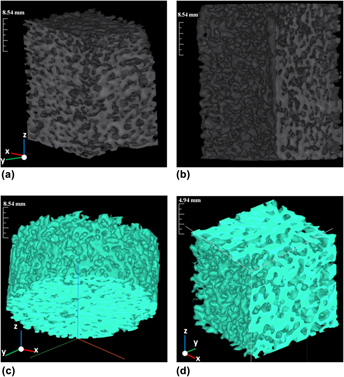Article contents
Effects of cell parameters at low strain rates on the mechanical properties of metallic foams of Al and 7075-T6 alloy processed by pressurized infiltration casting method
Published online by Cambridge University Press: 04 September 2018
Abstract

Cell morphology and relative density (ρrel) are two crucial intrinsic parameters controlling the mechanical properties of metal foams (MFs) and directly depend on their structure (closed/open-cell) and composition (affecting processing parameters). Here, we report on compressive studies of MFs of aluminum (Al) and 7075-T6 alloy processed via a customized route at strain rate, έ = 0.002 and 2.0 s−1. In both sets of MFs, the strength and apparent elastic modulus (E) monotonically increased with ρrel at both έ. At έ = 2.0 s−1, an increase in cell size (Cs) enhanced the strength of both sets of MFs, while at έ = 0.002 s−1, only the alloy foams showed strength increment. The densification strain (εd) of Al foams at έ = 0.002 s−1 monotonically decreased with increasing ρrel, whereas the alloy foams collapsed before the onset of densification. None of the MFs showed any particular trend of εd at έ = 2.0 s−1. The studies conclude that the mechanical properties of MFs with similar morphology, foam parameters, and processing route depend on έ and Cs. Absorption energy (W) and absorption efficiency (Im) of the two sets of MFs were also compared.
- Type
- Article
- Information
- Copyright
- Copyright © Materials Research Society 2018
References
REFERENCES
- 8
- Cited by




